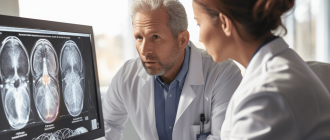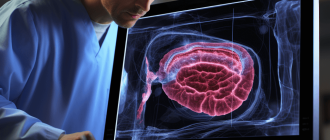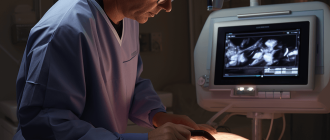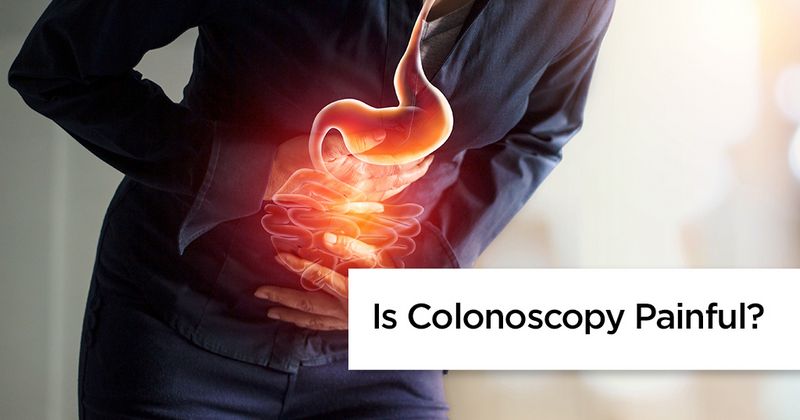
Understanding Colonoscopy with Biopsy: A Comprehensive Guide to the Procedure and Its Mechanism
A colonoscopy with biopsy is a medical procedure that allows a physician to examine the inner lining of your large intestine to identify potential abnormalities. This is an essential diagnostic tool in the detection and treatment of various gastrointestinal conditions, such as colorectal cancer, polyps, and inflammatory bowel disease.
The procedure involves the use of a colonoscope, a long, flexible tube that’s about half an inch in diameter. The colonoscope is equipped with a light and a tiny camera at its end, which transmits images to a monitor, providing the doctor with a clear, detailed view of your colon and rectum. If necessary, the physician may also perform a biopsy during the colonoscopy, taking small tissue samples for further examination under the microscope.
“A colonoscopy with biopsy is a significant step in the early detection of colorectal cancer, which can be highly treatable when caught early.”
Understanding the procedure can help alleviate some of the anxiety you may feel about undergoing a colonoscopy with a biopsy. In this article, we will explore what a colonoscopy with biopsy entails, how it works, and what you can expect before, during, and after the procedure.
What Is a Colonoscopy with Biopsy?
A colonoscopy is a medical examination that allows doctors to inspect the inner lining of your large intestine. This procedure is commonly done to screen for colon cancer and to investigate intestinal symptoms such as abdominal pain, rectal bleeding, and changes in bowel habits. The procedure involves the use of a long, flexible tube known as a colonoscope, which has a small video camera on the end.
A colonoscopy becomes a colonoscopy with biopsy when tissue samples are taken during the procedure. A biopsy is a procedure that involves the removal of a small amount of tissue for examination under a microscope. This is done to diagnose diseases and determine the exact nature and extent of any illnesses.
During a colonoscopy, the doctor can take biopsies from different areas of your colon. The biopsy samples are then sent to a lab, where a pathologist – a doctor who specializes in interpreting laboratory tests and evaluating cells, tissues, and organs to diagnose disease – will analyze them.
If the pathologist finds abnormal cells, such as cancer or precancerous cells, in the biopsy sample, your doctor will discuss the next steps with you. This could include treatment options or additional testing.
In conclusion, a colonoscopy with biopsy is a crucial medical procedure that aids in the detection and diagnosis of various intestinal diseases, including colon cancer.
Colonoscopy
A colonoscopy is a medical procedure that a healthcare provider uses to examine the inside of the large intestine (colon and rectum). It is performed using a long, flexible tube called a colonoscope. This procedure enables the doctor to view the entire colon, identify any abnormalities, and take tissue samples for further tests if necessary.
Here is how a colonoscopy procedure generally works:
| Step | Description |
|---|---|
| Preparation | Before the procedure, you need to clean out your colon. Your doctor will give you detailed instructions about what you need to do. This may involve a special diet, avoiding certain medications, and taking laxatives. |
| Procedure | During the procedure, you will lie on your side or back while your doctor slowly advances a colonoscope through your rectum into your colon. The scope inflates the colon with air to give the doctor a better view. A light and tiny camera at the end of the scope allows the doctor to view the inside of the colon. |
| Biopsy | If your doctor sees something that may be abnormal, small amounts of tissue can be removed for further analysis (biopsy). Polyps can also be removed during a colonoscopy procedure. |
| Post-procedure | After the procedure, you will rest in a recovery room until the sedatives wear off. Some people may experience minor discomfort or bloating due to the introduced air. You may be able to eat and drink normally after the procedure, but your doctor may recommend specific dietary instructions. |
Though a colonoscopy may seem daunting, it’s an essential tool for diagnosing and preventing diseases like colorectal cancer. If you have any concerns or questions about the procedure, don’t hesitate to speak with your healthcare provider.
Biopsy
A biopsy is a medical procedure that involves taking a small sample of body tissue so it can be examined under a microscope. This procedure is often used to determine whether a growth is benign (non-cancerous) or malignant (cancerous).
During a colonoscopy, a biopsy can be performed using a tool on the end of the colonoscope. This tool can take a small piece of tissue from the colon for further examination. The biopsy is generally painless, as the lining of the colon does not have a pain sensation similar to the skin and other tissues.
Once the tissue is taken, it is sent to a laboratory where a pathologist examines it. The pathologist is a doctor who specializes in diagnosing diseases by studying cells and tissues under a microscope. The results of the biopsy can help your doctor understand the nature of any abnormalities found during the colonoscopy.
It’s important to remember that a biopsy is usually a very safe procedure. Complications are rare but can include bleeding or perforation (hole) of the colon. Your doctor will discuss the risks with you before you undergo the procedure.
A biopsy is a crucial part of diagnosing diseases like cancer. It provides valuable information about your health and can guide your doctor in determining the best course of treatment.
Why is a Biopsy Taken During Colonoscopy?
A biopsy is taken during a colonoscopy to help doctors diagnose a variety of conditions. The primary reason is to test for colon cancer, but biopsies can also detect inflammatory bowel disease, diverticulosis, and other gastrointestinal disorders.
During a colonoscopy, a doctor uses a colonoscope, a long, flexible tube with a camera on the end, to examine the lining of the colon. If they find any suspicious areas, like polyps or inflamed tissue, they can take a biopsy for further examination. Here’s how the process works:
| Step | Description |
|---|---|
| 1 | The doctor guides the colonoscope through the colon until they find a suspicious area. |
| 2 | A small wire loop or forceps is passed through the colonoscope to take a sample of tissue. |
| 3 | The tissue sample is then sent to a lab, where it is examined under a microscope for any signs of disease. |
A biopsy taken during a colonoscopy is a crucial tool for diagnosing colon cancer and other gastrointestinal diseases. It is a simple and effective way to remove suspicious tissue for further testing, which can lead to early detection and treatment.
Searching for signs of tumors or polyps
During a colonoscopy, the gastroenterologist is mainly looking for polyps or tumors in your colon. Polyps are small, benign growths that can develop into cancer over time. On the other hand, tumors can be either benign (non-cancerous) or malignant (cancerous).
So how does the doctor search for these signs? The physician gently inserts a colonoscope, a long, flexible tube with a small video camera on the end, into your rectum and slowly guides it through your colon. The camera transmits an image to a monitor, allowing the doctor to carefully examine the lining of your colon.
If the doctor sees something suspicious, such as a polyp or a tumor, they can use special tools passed through the colonoscope to collect a sample of tissue. This is called a biopsy. The tissue sample is then sent to a lab where it’s examined under a microscope to determine whether it’s benign or malignant.
In summary, a colonoscopy not only allows for the detection of polyps or tumors, but it also enables the doctor to perform a biopsy which can confirm if the detected growth is cancerous or not.
Diagnosing Inflammatory Bowel Diseases
Inflammatory bowel diseases (IBD) such as Crohn’s disease and ulcerative colitis can be particularly challenging to diagnose due to their complex and often non-specific symptoms. However, a colonoscopy with biopsy is one of the most reliable methods for diagnosing and managing these conditions.
Colonoscopy with Biopsy
A colonoscopy is a procedure that allows doctors to examine the entire length of the colon or large intestine. This procedure is performed using a flexible tube called a colonoscope, which is inserted into the rectum and advanced through the colon. The colonoscope is equipped with a small camera that transmits images to a monitor, allowing the doctor to visualize any abnormalities in the colon.
If any suspicious areas are detected during the colonoscopy, a biopsy can be performed. During a biopsy, small samples of tissue are removed from the colon for further examination under a microscope. This can help to confirm the presence of inflammation, ulcers, or other signs of IBD.
Note: While a colonoscopy with biopsy is a highly effective tool for diagnosing IBD, it is just one component of a comprehensive diagnostic approach. Other tests and procedures, such as blood tests, stool tests, and imaging studies, may also be necessary to confirm a diagnosis and guide treatment decisions.
Preparing for a Colonoscopy
Before a colonoscopy, it’s essential to fully empty the colon. This is typically achieved through a combination of a special diet and laxatives. It’s important to follow all pre-colonoscopy instructions closely to ensure the most accurate results.
Investigating unexplained symptoms such as rectal bleeding
Unexplained symptoms like rectal bleeding can be a cause for concern. It’s important to investigate these symptoms thoroughly to understand the underlying cause and initiate appropriate treatment. One effective method to investigate these symptoms is through a procedure known as a colonoscopy with biopsy.
A colonoscopy is a procedure that allows a doctor to look at the inner lining of your large intestine. The procedure involves the use of a thin, flexible tube called a colonoscope. This device has a small camera and light source attached to its end, enabling the doctor to closely examine the colon’s interior.
If the doctor observes any abnormal tissues during the colonoscopy, they may perform a biopsy. A biopsy involves removing a small piece of tissue for further examination under a microscope. This can help to identify any abnormalities at a cellular level, such as inflammation, infection, or even cancer.
It is crucial to remember that rectal bleeding can be a symptom of several conditions, including hemorrhoids, anal fissures, and colorectal cancer. Therefore, it should never be ignored. If you experience such symptoms, it is important to consult with a healthcare professional at the earliest.
Monitoring the condition of existing diseases and the effectiveness of treatment
Colonoscopy with biopsy is a crucial procedure for monitoring the condition of existing gastrointestinal diseases and evaluating the effectiveness of ongoing treatments. By providing a detailed view of the inner lining of the colon, this procedure allows doctors to detect any changes in the condition of the patient.
The biopsy aspect involves taking small tissue samples from the colon. These samples are then analyzed in the laboratory to determine the nature and extent of the disease. This is particularly useful in monitoring diseases like Crohn’s disease, ulcerative colitis, and colon cancer. It can also help detect any abnormalities that can indicate the progression or regression of the disease.
Through regular colonoscopies, doctors can assess the effectiveness of treatments and make necessary adjustments to enhance patient outcomes. For instance, if a patient’s condition is not improving as expected, the treatment approach can be modified accordingly. Conversely, if the patient is responding well to treatment, the colonoscopy will provide evidence of this improvement, and the current treatment approach can continue.
Therefore, colonoscopy with biopsy is an invaluable tool in the management and treatment of gastrointestinal diseases. It enables personalized treatment plans and contributes to better patient outcomes.
How Does the Procedure Work?
A colonoscopy with biopsy is a medical procedure that allows physicians to examine the lining of your colon and to take tissue samples for further examination. The procedure is performed using a tool known as a colonoscope, which is a long, flexible tube equipped with a tiny video camera and a light on its end.
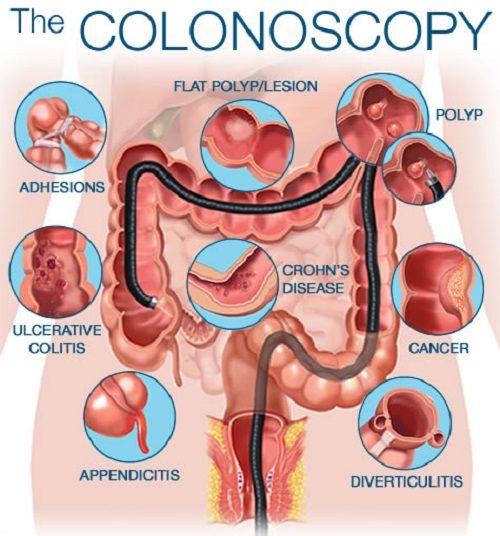
The procedure usually begins with the patient being positioned on his or her side on the examination table. A sedative is often given to help the patient relax and minimize discomfort. Then, the colonoscope is carefully inserted into the anus and slowly guided through the rectum and into the colon.
The camera on the colonoscope transmits images to a monitor, allowing the doctor to carefully examine the colon. If necessary, instruments can be passed through the colonoscope to perform a biopsy. This involves taking a small sample of tissue, which will then be sent to a lab for further testing.
It’s important to note that a colonoscopy with biopsy is typically a safe procedure with a low risk of complications. However, like any medical procedure, it can still carry risks. Therefore, it’s crucial to discuss these potential risks with your healthcare provider before the procedure.
After the procedure, patients usually need time to recover from the sedative. It’s recommended to have a friend or family member present to drive the patient home.
Patients may experience some bloating or cramping right after the procedure, but these symptoms usually disappear quickly. Any tissue samples taken during the procedure will be sent to a lab for analysis. Patients will need to follow up with their healthcare provider to discuss the results.
Remember: Preparation for a colonoscopy can start several days before the procedure, and may include dietary changes and taking certain medications. Always follow your healthcare provider’s specific instructions to ensure the best possible outcomes.
What to do after a colonoscopy with biopsy?
After a colonoscopy with biopsy, you may feel a bit groggy from the sedation. It’s important to have someone with you to drive you home and stick around for a few hours to ensure you’re okay. Make sure to rest and take it easy for the rest of the day.
You should also pay attention to your body in the days following the procedure. It’s normal to experience some cramping or bloating, as well as a small amount of bleeding. However, if you have severe pain, heavy bleeding, fever, or dizziness, you should contact your doctor immediately as these could be signs of complications.
Remember to stay hydrated and eat light, easily digestible foods for the first day or so after your colonoscopy. Avoid foods that are high in fiber until your doctor gives you the go-ahead, as these can be hard on your digestive system as it recovers.
Finally, make sure to follow your doctor’s instructions regarding any medication you were taking before the procedure. Some medications may need to be adjusted or temporarily stopped, especially if biopsies were taken.
In conclusion, taking care of yourself after a colonoscopy with biopsy is crucial for your recovery. Listen to your body, follow your doctor’s advice, and don’t hesitate to reach out if you have any concerns.
Can I return to regular activities immediately after a colonoscopy with biopsy?
Typically, most people can return to their regular activities 24 hours after a colonoscopy with biopsy. However, the exact time may vary depending on the specific circumstances of the procedure and the individual’s response.
It’s important to understand that the sedatives used during the procedure can last in your system for up to 24 hours. This means you may feel drowsy and it’s recommended not to drive, operate machinery, or make important decisions during this period.
While you may feel fine, your body is still recovering from the procedure. You may experience some mild cramping or bloating due to the air introduced into the colon during the procedure. This should resolve naturally over a short period of time.
Another factor to consider is the biopsy results. If your doctor has removed polyps or taken tissue samples, you may need to follow specific instructions. This could include dietary modifications or taking prescribed medications to assist with healing and prevent complications.
Always follow the advice of your healthcare provider regarding when it’s safe to return to your normal activities. If you experience severe abdominal pain, fever, bloody stool, or dizziness, seek medical attention immediately.
How accurate is a colonoscopy with biopsy?
A colonoscopy with biopsy is considered a highly accurate procedure for diagnosing diseases and conditions of the colon and rectum. This procedure allows for direct visualization of the interior of the colon, which makes it an excellent tool for detecting abnormalities such as polyps and tumors.
Accuracy of Detecting Polyps and Cancer
Studies have shown that colonoscopy with biopsy has a high sensitivity for detecting colorectal polyps and cancer. In fact, colonoscopy is often referred to as the ‘gold standard’ for colorectal cancer screening. However, the accuracy can depend on several factors, including the size and location of the polyps, the skill and experience of the endoscopist, and the quality of the bowel preparation prior to the procedure.
False Negatives and Positives
While colonoscopy with biopsy is highly accurate, it is not infallible. There is a small chance of false negatives, where a polyp or cancer is present but not detected during the procedure. Similarly, there can also be false positives, where a detected polyp is not actually cancerous. However, these instances are relatively rare, and the overall accuracy of colonoscopy with biopsy is quite high.
In conclusion, a colonoscopy with biopsy is a highly accurate diagnostic tool for detecting abnormalities in the colon and rectum. However, as with any medical procedure, it is not 100% accurate and there are several factors that can influence its accuracy.
Can there be complications after a colonoscopy with biopsy?
Like any medical procedure, a colonoscopy with a biopsy can potentially lead to complications. Although these are relatively rare, it is important to understand the risks involved.
Bleeding: This is the most common complication after a colonoscopy with a biopsy. It can occur if a blood vessel is injured during the procedure. Most times, the bleeding is minor and stops on its own. However, in rare cases, it might require additional treatment.
Infection: Any procedure that involves breaking the skin, including a biopsy, carries the risk of infection. The risk of infection after a colonoscopy with biopsy is minimal, but it can happen. If you notice signs of infection such as fever, chills, or increased pain at the biopsy site, it’s important to contact your healthcare provider immediately.
Perforation: A perforation, or tear, in the colon or rectum is a rare but serious complication of a colonoscopy with biopsy. This can cause severe abdominal pain and requires immediate medical attention.
Remember: The benefits of a colonoscopy with biopsy typically outweigh the potential risks. This procedure can detect early signs of colon cancer and other digestive diseases, which can significantly improve treatment outcomes. It is crucial to discuss any concerns with your healthcare provider before the procedure.
What diseases can be detected by a colonoscopy with biopsy?
A colonoscopy with biopsy is a highly effective procedure that can diagnose a range of diseases and conditions. The procedure involves the use of a colonoscope, a long, flexible tube with a tiny camera on the end, to examine the inner lining of the large intestine. If any abnormal tissue is detected, a biopsy can be performed to remove cells for further analysis.
The following table lists some of the most common diseases and conditions that can be detected through this procedure:
| Disease or Condition | Description |
|---|---|
| Colorectal cancer | This is a type of cancer that starts in the colon or rectum. It is the third most common type of cancer in the United States. |
| Inflammatory bowel disease (IBD) | This is a term that refers to two conditions, Crohn’s disease and ulcerative colitis, which cause chronic inflammation of the digestive tract. |
| Diverticulosis and Diverticulitis | Diverticulosis is a condition where small pouches, called diverticula, form in the colon wall. If these pouches become inflamed or infected, it is known as diverticulitis. |
| Polyps | Polyps are small clumps of cells that form on the lining of the colon. While most are harmless, some can develop into colon cancer over time. |
| Bleeding in the digestive tract | A colonoscopy can help identify the source of unexplained bleeding in the digestive tract. |
It’s important to note that a colonoscopy with biopsy is not only a diagnostic tool but also a preventative one. It allows for the early detection and removal of precancerous polyps, significantly reducing the risk of developing colorectal cancer.
Can I decide if I need a colonoscopy with biopsy?
The decision to have a colonoscopy with biopsy is usually based on a recommendation from your healthcare provider. The need for this procedure is typically determined by various factors such as your age, family history of colon cancer or polyps, and your personal health history.
Colonoscopy with biopsy is often recommended for individuals who:
- Are aged 50 and above
- Have a family history of colon cancer or polyps
- Have symptoms such as abdominal pain, rectal bleeding, weight loss, or changes in bowel habits
- Have been diagnosed with inflammatory bowel disease (IBD) such as Crohn’s disease or ulcerative colitis
However, it is important to note that the final decision rests with you as the patient. It is crucial to discuss your concerns, understand the potential risks and benefits, and weigh these against your personal health goals before making a decision.
Remember, early detection is key in managing and treating many colorectal conditions. Regular screening through procedures like colonoscopy with biopsy is an effective way to catch any potential issues early.
How long is the recovery time after a colonoscopy with biopsy?
Recovery time after a colonoscopy with biopsy can vary greatly depending on a number of factors. However, in general, most people will begin to feel better within a few hours of the procedure.
Immediately After the Procedure:
After the colonoscopy, you will be monitored in a recovery area for 1-2 hours until the effects of the sedatives wear off. It’s important to have someone with you to drive you home as you may still feel groggy from the sedation.
The Next 24 Hours:
People are often able to return to their regular activities the day after the procedure. However, you may experience some bloating, cramping or gas due to the air introduced into your colon during the procedure. This should go away within 24 hours.
Recovery from the Biopsy:
If a biopsy was taken during the colonoscopy, the recovery may take a little longer. It usually takes about 2-3 days for the biopsy site to completely heal. During this time, it is normal to see a small amount of blood in your stool. If you experience heavy bleeding, severe abdominal pain, or a fever, you should contact your doctor immediately.
In conclusion, the body often recovers quickly from a colonoscopy with biopsy, but everyone’s experience can vary. Always follow your doctor’s specific instructions for aftercare and recovery to ensure the best outcome.
Question-answer
What exactly is a colonoscopy with biopsy?
A colonoscopy with biopsy is a medical procedure that allows your doctor to examine the inner lining of your large intestine (rectum and colon). They use a thin, flexible tube called a colonoscope to look at the colon. A biopsy is the removal of a small amount of tissue for examination under a microscope. Therefore, during this procedure, if the doctor sees anything suspicious, they can take a small sample of tissue (biopsy) to examine more closely.
Why would a doctor recommend a colonoscopy with biopsy?
A doctor might recommend a colonoscopy with biopsy if you have symptoms such as changes in bowel habits, rectal bleeding, persistent abdominal discomfort or unexplained weight loss. This procedure can help the doctor find the cause of these symptoms. It’s also used to screen for colorectal cancer, as it can detect early stages of cancer when treatment is most likely to be effective.
What does the procedure of colonoscopy with biopsy involve?
The procedure involves inserting a long, flexible tube (colonoscope) into the rectum. The tube has a tiny video camera at the tip, which sends images to an external monitor so the doctor can study the inside of your colon. If necessary, the doctor can use special tools through the tube to remove polyps or other abnormal tissues, which will be sent to a lab for testing. You will be sedated during this procedure to prevent discomfort.
How should one prepare for a colonoscopy with biopsy?
Before a colonoscopy, you’ll need to clean out your colon. This is often done by following a special diet for a day or two before the procedure and taking a strong laxative the night before. You may also need to adjust your usual medication regimen. It’s important to discuss your medical history and all medications you’re taking with your doctor beforehand.
Are there any risks or side effects associated with a colonoscopy with biopsy?
Like any procedure, a colonoscopy with biopsy carries a small risk of complications. These might include bleeding from the site where the biopsy was taken or a perforation in the colon or rectum wall. Some people might also have an adverse reaction to the sedative used during the procedure. After the procedure, you might experience minor discomfort or bloating, but these symptoms usually resolve quickly.

